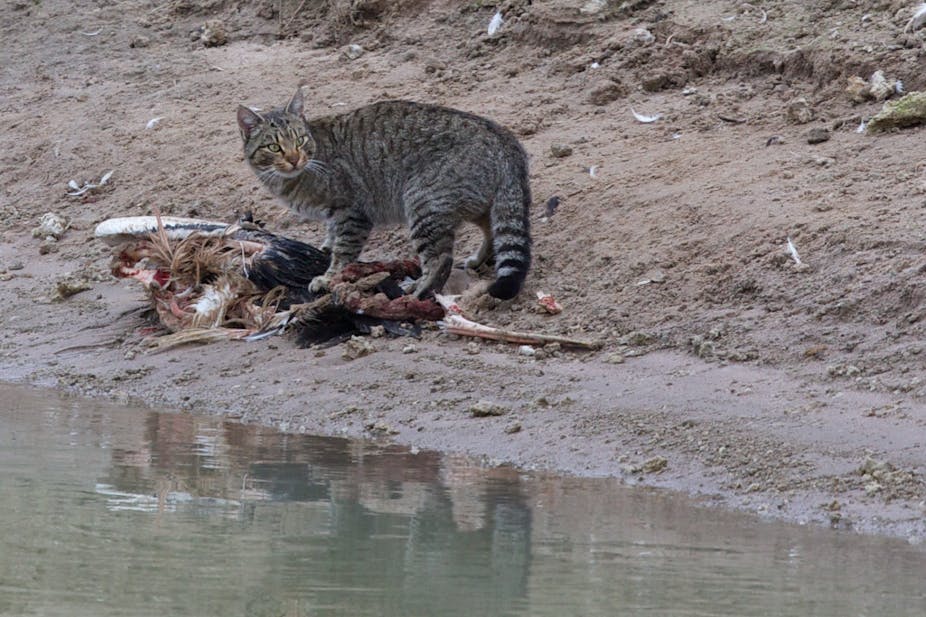Australia has suffered more than most countries from invasive species. Predators such as the red fox and feral cat have been especially destructive, threatening native wildlife and imposing huge costs on farming.
The usual response to these problems is “culling”: killing or otherwise removing pest animals from wild populations with the aim of reducing their abundance and impact, or even eradicating them.
But a recent study shows that culling can backfire badly. Wildlife biologists in Tasmania decided to test their ability to reduce abundance of feral cats. They surveyed cats in four large areas of native forest, and then trapped and removed animals for a year in two of those areas.
This seemed to go really well: at first they caught lots of cats, then trap success rapidly dropped off, suggesting most cats had been removed. The problem was that monitoring with remote cameras showed that as resident cats were taken out even more new cats appeared. These newcomers did not enter traps. As a result the abundance of cats actually went up in areas being trapped.
This is not an isolated bit of weirdness: similar effects have been found elsewhere. For example, a study of ferrets on a British island showed that trapping and removal resulted in a doubling of the size of the ferret population over pre-culling levels.
What went wrong?
What seems to have happened in these cases is that young animals quickly moved in from surrounding areas to replace dominant adults removed in the cull. Most of these young animals would normally have died. The sudden increase in their survival allowed abundance to overshoot pre-cull levels.
The challenge this creates for pest managers is a bit like the one faced by Hercules when he was told to go and slay the hydra, a monstrous many-headed serpent which sprouted two heads in place of each one that Hercules cut off.

The more general problem is that removing some animals from a population creates more space and food for those that are left, and can disrupt social controls on breeding. Survival, reproduction and immigration all increase as a result, and the population quickly rebounds.
For culling to produce a lasting reduction in abundance, it is essential not just to accomplish the relatively easy task of removing animals from a high-density population. We also need to be able to continue removing animals at rates that equal or exceed the capacity for increase of a population with improved survival and reproduction.
Often, this can’t be done, so the initial knockdown in abundance has no lasting benefit. People often defend culling programs by pointing to the numbers killed and saying something like “…and those X thousand cats/foxes/rabbits that we killed are no longer out there damaging the environment”. That is a fallacy.
Choose your battles wisely
This does not mean that it is never possible to reduce or eradicate populations of pest species. Australia can chalk up some recent successes in this. Two of the most significant are the reduction of camels across central Australia and the eradication of cats, rabbits and rodents from Macquarie Island. But successes like these are most likely to be won under quite particular conditions.

These include choosing situations (like islands) where culled animals won’t quickly be replaced by immigrants, and using methods or combinations of methods that can not only take animals out of abundant populations but are also efficient in continuing to remove them from low-density populations.
In any case it is essential that culling programs have clear goals, are well co-ordinated and target species and places where achieving those goals is justified by the environmental and economic benefits. Most importantly, the effectiveness of culling should be evaluated by monitoring the activity and impacts of pest populations.
Unfortunately, a lot of culling activity falls well short of these standards. A current example is the Victorian government’s fox bounty scheme.
This supports widespread and unco-ordinated culling that is unlikely to significantly reduce fox populations anywhere, let alone in the places where they cause most damage. There is no evaluation of the program’s effectiveness; given the recent study of cats in Tasmania, it could be doing more harm than good.
All we know for certain is that it costs millions of dollars. We should be able to do better than that.

